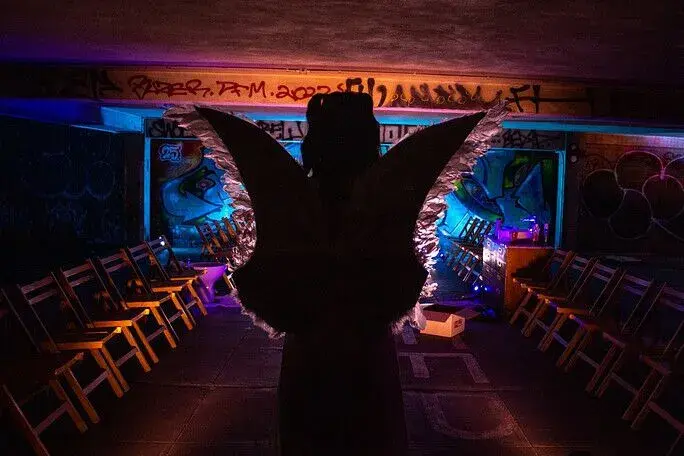The Lord of the Rings: A Musical Tale- Review
- Tayla Ham (she/her)

- May 5
- 3 min read
Updated: May 6
Allow this ensemble of exceptionally skilled performers to take you on a journey through Tolkien’s Middle-Earth in a fresh adaptation of the classic narrative, "The Lord of the Rings - A Musical Tale."
Fans of the classic The Lord of the Rings trilogy and theatre enthusiasts alike will love this production (even if they have not seen or read all of the original material, like me). The story moves quickly, keeping the audience on the edge of their seats. In just over three hours, the cast tells this timeless tale, with incredibly talented performers singing, acting, dancing, and playing instruments on stage simultaneously.

When it comes to the talent of this cast, there were numerous outstanding performances, including Rarmian Newton as Frodo and Wern Mak as Samwise Gamgee. As the leading duo of the show, they shared a beautiful connection and truly felt like friends throughout the performance.
However, it would be amiss to review this show without mentioning the performance of Laurence Boxhall as “Gollum.” While not appearing until Act 2, he makes himself known, truly transforming into the creature of Gollum. Boxhall embodies the physicality of Gollum, cowering as he speaks. He moves in a creepy, creature-like way that is half-crawling, half-running, and the fight scenes between Boxhall and Newton are just electrifying.
Additionally, Boxhall displays two distinct voices and argues with himself, showcasing the duality of Gollum and providing the audience with a deeper understanding of why Frodo feels pity for him, despite him being a threat to his life. Boxhall even sings in these two different character voices, which initially seems humorous but becomes somewhat disturbing as the scene unfolds.
“The Lord of the Rings - A Musical Tale” features an original score with orchestrations by Christopher Nightingale, A.R. Rahman, and Värttinä, while the book and lyrics are by Shaun McKenna and Matthew Warchus.
The score perfectly captures the essence of Middle-Earth, with the Hobbits showcasing more folk-style songs. In contrast, the songs performed in the elven realms, especially Jemma Rix’s performance as Galadriel, felt much more ethereal and otherworldly.
The choreography, by Anjali Mehra, was always exquisite and beautifully performed by the full company. With a different feel for the various styles of songs, for example, the elves used graceful, purposeful, yet flowing arm and hand movements, somewhat reminiscent of Indian dance. This contrasts with the Orcs, whose movement was acrobatic, forceful, and low to the ground.

When the audience first enters the theatre, the hobbits are on stage performing and mingling with the attendees, engaging in games with them. This fosters an inclusive, joyful, and welcoming atmosphere. The hobbits invite the audience into The Shire and seamlessly transition into the show's beginning by singing "Happy Birthday" to Bilbo Baggins.
Beginning the show this way perfectly matches director Paul Hart’s original vision for the production. He wanted the audience to feel like they were being invited to join the company of hobbits in The Shire as they retold the legendary story of Frodo and The Ring.
The only noticeable aspect of starting the show with this smooth transition was the absence of a pre-show announcement. This meant that it was not announced that Hanolan Innocent was playing Legolas (when he is not in the program); this information is only available on the cast list on the website, which states that he is covering for the Melbourne run of the production. Additionally, there was no Acknowledgement of Country, which, considering they used traditional Indigenous instruments such as a didgeridoo during the show, is an interesting choice for the production.
The use of the theatre space was truly interesting throughout the show, with the cast, especially Frodo and his companions, moving around the theatre's auditorium and walking down in front of the stage. This effectively conveyed a sense of a journey, or that they were attempting to hide from the giant horse puppets, and kept the audience involved in the show.
Multiple times throughout the show showcased beautiful uses of puppetry, which helped bring this magical, mystical story to life. The giant spider in Act 2 stands out as a highlight of the show, with its slow, menacing approach toward Frodo being frightening, and the puppetry was so well executed that you forgot it wasn’t real.
Whether you are a diehard Lord of the Rings fan or new to the franchise, you’ll enjoy this adventure into Middle-Earth and The Shire. Along with seeing the amazing Australian talent on stage, it’s an edge-of-your-seat adventure that somehow takes this epic trilogy and perfectly adapts it for the stage.







